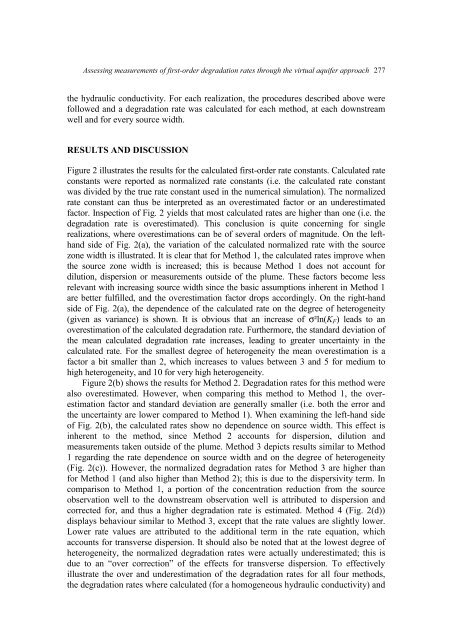Applied numerical modeling of saturated / unsaturated flow and ...
Applied numerical modeling of saturated / unsaturated flow and ...
Applied numerical modeling of saturated / unsaturated flow and ...
You also want an ePaper? Increase the reach of your titles
YUMPU automatically turns print PDFs into web optimized ePapers that Google loves.
Assessing measurements <strong>of</strong> first-order degradation rates through the virtual aquifer approach 277<br />
the hydraulic conductivity. For each realization, the procedures described above were<br />
followed <strong>and</strong> a degradation rate was calculated for each method, at each downstream<br />
well <strong>and</strong> for every source width.<br />
RESULTS AND DISCUSSION<br />
Figure 2 illustrates the results for the calculated first-order rate constants. Calculated rate<br />
constants were reported as normalized rate constants (i.e. the calculated rate constant<br />
was divided by the true rate constant used in the <strong>numerical</strong> simulation). The normalized<br />
rate constant can thus be interpreted as an overestimated factor or an underestimated<br />
factor. Inspection <strong>of</strong> Fig. 2 yields that most calculated rates are higher than one (i.e. the<br />
degradation rate is overestimated). This conclusion is quite concerning for single<br />
realizations, where overestimations can be <strong>of</strong> several orders <strong>of</strong> magnitude. On the lefth<strong>and</strong><br />
side <strong>of</strong> Fig. 2(a), the variation <strong>of</strong> the calculated normalized rate with the source<br />
zone width is illustrated. It is clear that for Method 1, the calculated rates improve when<br />
the source zone width is increased; this is because Method 1 does not account for<br />
dilution, dispersion or measurements outside <strong>of</strong> the plume. These factors become less<br />
relevant with increasing source width since the basic assumptions inherent in Method 1<br />
are better fulfilled, <strong>and</strong> the overestimation factor drops accordingly. On the right-h<strong>and</strong><br />
side <strong>of</strong> Fig. 2(a), the dependence <strong>of</strong> the calculated rate on the degree <strong>of</strong> heterogeneity<br />
(given as variance) is shown. It is obvious that an increase <strong>of</strong> σ²ln(KF) leads to an<br />
overestimation <strong>of</strong> the calculated degradation rate. Furthermore, the st<strong>and</strong>ard deviation <strong>of</strong><br />
the mean calculated degradation rate increases, leading to greater uncertainty in the<br />
calculated rate. For the smallest degree <strong>of</strong> heterogeneity the mean overestimation is a<br />
factor a bit smaller than 2, which increases to values between 3 <strong>and</strong> 5 for medium to<br />
high heterogeneity, <strong>and</strong> 10 for very high heterogeneity.<br />
Figure 2(b) shows the results for Method 2. Degradation rates for this method were<br />
also overestimated. However, when comparing this method to Method 1, the overestimation<br />
factor <strong>and</strong> st<strong>and</strong>ard deviation are generally smaller (i.e. both the error <strong>and</strong><br />
the uncertainty are lower compared to Method 1). When examining the left-h<strong>and</strong> side<br />
<strong>of</strong> Fig. 2(b), the calculated rates show no dependence on source width. This effect is<br />
inherent to the method, since Method 2 accounts for dispersion, dilution <strong>and</strong><br />
measurements taken outside <strong>of</strong> the plume. Method 3 depicts results similar to Method<br />
1 regarding the rate dependence on source width <strong>and</strong> on the degree <strong>of</strong> heterogeneity<br />
(Fig. 2(c)). However, the normalized degradation rates for Method 3 are higher than<br />
for Method 1 (<strong>and</strong> also higher than Method 2); this is due to the dispersivity term. In<br />
comparison to Method 1, a portion <strong>of</strong> the concentration reduction from the source<br />
observation well to the downstream observation well is attributed to dispersion <strong>and</strong><br />
corrected for, <strong>and</strong> thus a higher degradation rate is estimated. Method 4 (Fig. 2(d))<br />
displays behaviour similar to Method 3, except that the rate values are slightly lower.<br />
Lower rate values are attributed to the additional term in the rate equation, which<br />
accounts for transverse dispersion. It should also be noted that at the lowest degree <strong>of</strong><br />
heterogeneity, the normalized degradation rates were actually underestimated; this is<br />
due to an “over correction” <strong>of</strong> the effects for transverse dispersion. To effectively<br />
illustrate the over <strong>and</strong> underestimation <strong>of</strong> the degradation rates for all four methods,<br />
the degradation rates where calculated (for a homogeneous hydraulic conductivity) <strong>and</strong>

















